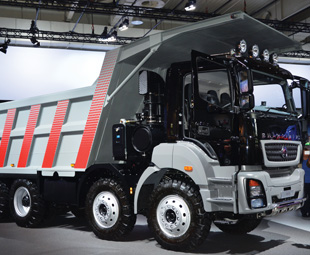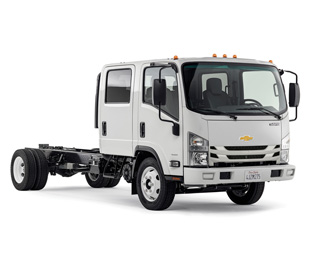Busy brizzy truck show

In his monthly review of global news for local truckers, FRANK BEETON takes a look at interesting exhibits at the Brisbane Truck Show, updates developments at Daimler’s Indian commercial vehicle operations and reveals a surprising turn in relations between General Motors and Isuzu.
Regular readers will be well aware that Global Focus has made a habit of keeping a close watch on developments in the Australian truck market. That market is probably more similar, in both size and composition, to our own South African version than any other on Planet Earth.
It’s not identical, however, because Australia is further down the compulsory emissions road than we are (the current ADR 80/03 standard approximates to Euro 5), and Aussie operators still tend to favour American trucks at the top end of the mass spectrum, whereas local truckers have swung increasingly to European brands in recent years.
Australia has a number of truck specialist shows, of which those in Brisbane and Melbourne are the most significant, and provide us with a convenient window into new model arrivals and emerging trends that may influence future market direction “down under”.
New Actros hits Oz
The 2015 Brisbane Truck Show, which was held from May 14 to 17, at that city’s Convention and Exhibition Centre, provided the venue for the first public appearance of the latest generation Mercedes-Benz Actros in Australia.
This state-of-the-art European product series, together with the Arocs construction line-up and the Antos distribution family, are due to enter the Australian market in mid-2016. This suggests that Daimler Trucks is more comfortable exposing its latest generation global engine technology to Australia’s Euro-5 equivalent fuel quality than to South Africa’s predominantly Euro-2 level.
Despite its acknowledged leadership position in much of the global truck market, Mercedes-Benz has long been considered to be an under-performer in Australia. Every effort is now being made to improve this situation with the new range. These measures will start with an extensive period of operator evaluation and testing, to eliminate any potential problems prior to retail launch.
The Australian line-up will cater for a wide spectrum of applications from local distribution to road trains, with engine displacements of eight, 11, 13 and 16 litres, and outputs of up to 470 kW (630 hp).
Another interesting new product, on view from the Daimler Trucks family, was the Western Star 2800, with a driveline specification that includes the Cummins ISBE6 engine and Allison 3000-Series transmission.
Based on the Freightliner Business Class range, this mid-sized (16 to 22,5 t gross vehicle mass (GVM)) two- and three-axle bonneted distribution truck range, has been positioned poles apart from the premium haulers usually associated with the Western Star brand.
This reflects the unique distribution model employed by Western Star in Australasia, where the brand, together with MAN, is distributed by the Penske Commercial Vehicles organisation, and is not managed by Mercedes-Benz Asia/Pacific alongside other family brands Mercedes-Benz, Freightliner and Fuso.
Navistar Developments
In sharp contrast to its diminished position as a vehicle supplier in the South African trucking scene, Navistar International has been cranking up its involvement in Australia. Last year, the group’s Australia Pacific operation dropped its increasingly redundant NC² title to become Navistar Auspac. It also recruited Tim Quinlan, who is well known in the South African trucking community, as its managing director.
It has also recently announced that the International truck brand will be returning to the Australian market, presumably alongside the CAT Trucks badge, which has been used to rebuild Navistar’s presence “down under” following its formal separation from the earlier joint venture with Iveco in 2010.
The Brisbane show was used as the launch venue for the new CT630HD model from CAT Trucks, which is specifically intended for double and triple road-train applications up to 131 t gross combination mass (GCM).
The impressive standard specification includes a 15,2-litre CAT C15 engine developing 410 kW (550 hp), 18-speed Eaton Fuller RTLO 20918B gearbox, 6,5-t Meritor MFS front axle, 22,7-t Meritor RT50-160GP tandem rear bogie, and Hendrickson Primaax EX road-friendly rear air suspension.
Other features include a reinforced chassis, raised normal control cab, high-flow twin-cylinder air compressor, and increased air-cleaner capacity with centrifugal pre-cleaner.
Other Interesting Exhibits
Volvo Group exhibits at Brisbane were mainly centred on customer experience rather than new products, although group member UD Trucks did celebrate its 80th anniversary with two new Condor cruiserweight models; the PD 24 280 RAA and the MK Tipper.
The former model is a 23,5-t GVM, 6×2 freight carrier with 206 kW (280 hp) output, offering a choice of nine-speed Eaton manual or six-speed Allison automatic transmissions. The 180 kW (240 hp) MK Tipper has a payload capacity of 5,5 t carried in a factory-fitted tipper body, and is equipped with an Allison automatic transmission.
Hino is also celebrating an anniversary (this being its 50th year in the Australian market), with a new FE 1426 Auto model, while arch-rival Isuzu exhibited its FYJ 2000 8×4 chassis with agitator (mixer) superstructure.
Scania provided a pre-Australian launch viewing of its R730 V8 Euro-6 flagship model, while Paccar’s DAF brand exhibited a new 8×4 variant of its XF105 line-up.
DAIMLER’S GROWING INDIAN CONNECTION
During 2010, Daimler AG sold the 5,34 percent shareholding, that it had held since 1954, in Indian manufacturer Tata Motors.
The German manufacturer, through its Mercedes-Benz truck brand, had been the technology supplier for the initial range of indigenous commercial vehicles produced by Tata. It had refrained from direct competition with those vehicles in their own domestic market while the partnership held firm.
However, Tata subsequently moved to an increasingly independent course, which included the establishment of a diesel engine manufacturing partnership with Cummins, the acquisition of Daewoo’s South Korean medium- and heavy-truck manufacturing operations, and some engine sourcing from Iveco. This latter arrangement has more recently evolved into a business relationship with Fiat Powertrain Technologies.
After the equity-based relationship between Daimler and Tata was terminated, Daimler India Commercial Vehicles was established with the objective of moving aggressively into the local commercial vehicle market.
This process started in mid-2006 with the importation of heavy-duty Mercedes-Benz Actros tippers for sale to the Indian mining industry. It also invloved the setting up of an arrangement with Sutlej Motors Limited covering the provision of luxury coach bodies for fitment to rear-engined bus chassis.
Construction was then started on a new commercial vehicle manufacturing plant at Oragadam, near Chennai, and products from the Japanese-sourced Mitsubishi Fuso truck range were introduced to India at the beginning of 2010.
BharatBenz Appears
The indigenous medium and heavy-duty products of DICV’s Chennai plant were branded BharatBenz (“Bharat” is the Hindi language word for India) when production commenced in 2012, and were derived from a selection of Mercedes-Benz and Fuso base models.
 In addition to re-establishing the Daimler family as a serious contender for Indian market sales, these commercial vehicles have also been exported to Bangladesh, Kenya, Sri Lanka, Zambia, Tanzania and Zimbabwe.
In addition to re-establishing the Daimler family as a serious contender for Indian market sales, these commercial vehicles have also been exported to Bangladesh, Kenya, Sri Lanka, Zambia, Tanzania and Zimbabwe.
Interestingly, the “Benz” suffix seems to have particularly strong appeal in Asian markets, and a number of joint ventures and licensing agreements in that region involving Daimler group products have adopted that name as part of branding, in preference to “Daimler” or “Mercedes”.
During May, it was announced that more than 20 000 BharatBenz trucks were already operational in India and that an investment of €50 million (R680 million) was being made to build a specific bus production plant at the Chennai location.
This plant, which was opened in June, will expand the production capacity of buses with GVM ratings of nine tonnes and above to an initial volume of 1 500 units per annum.
The front-engined bus models – mainly intended for school, staff and tourist applications – are being marketed under the BharatBenz name, while the rear-engined coach models, that are to be introduced as part of this expansion programme, will carry Mercedes-Benz branding.
It is notable that British bodybuilder Wrightbus also has a presence in the Chennai plant to mount lightweight aluminium bodies on the BharatBenz front-engined chassis range.
In January, initial shipments of nine-tonne GVM OF series front-engined bus chassis were made from Chennai to the MCV plant in El Salam City, Cairo. MCV has been a business partner of Daimler for some time. The complete buses, with Mercedes-Benz branding, are now being sold through the MCV sales network in Egypt.
A New, More Powerful Indian Truck Model
The BharatBenz truck line-up is also being expanded to include a four-axle, 48-t GVM 3143 model, intended for mining and construction applications. This unit will be powered by the in-line, six-cylinder Mercedes-Benz OM 457 engine developing 320 kW (430 hp).
It is claimed that it will be the most powerful truck available on the Indian market, which in the past has favoured lower-powered products. The availability of this power option will also be a positive factor in the expansion of DICV’s export efforts to regions such as the Middle East and Latin America.
Early moves have confirmed that Daimler Trucks fully intends to exploit the potential of BharatBenz products and its supporting infrastructure across a substantial global footprint, this being the fifth brand in the group’s portfolio alongside Mercedes-Benz, Freightliner, Mitsubishi Fuso and Western Star.
The recent arrival of the DICV OF 917RF bus chassis on the South African market suggests that other products from this source may be under consideration for sale locally.
In an environment where parent Daimler continues to be frustrated by the lack of quality, clean diesel fuel in this country, there must be more than an even chance that some BharatBenz products may find their way into Mercedes-Benz South Africa’s product strategy.
GENERAL MOTORS AND ISUZU RE-ESTABLISH THEIR NORTH AMERICAN TRUCK COOPERATION
Back in 2009, General Motors (GM) put an end to its long-running North American truck cooperation with Isuzu Motors Limited and closed down the associated marketing and manufacturing operations.
 Up to that time, some 470 GM dealers had been active in the very successful sale of medium-duty trucks across the United States (US) and Canada. This decision seemed to end GM’s own-account involvement with any commercial vehicle business larger than pickups or light vans.
Up to that time, some 470 GM dealers had been active in the very successful sale of medium-duty trucks across the United States (US) and Canada. This decision seemed to end GM’s own-account involvement with any commercial vehicle business larger than pickups or light vans.
By March 2006, GM had disposed of its final shareholding in Isuzu Motors, ending an equity-holding relationship which first commenced in 1971.
Since its own initial entry to the US truck market in 1984, Isuzu had, up to that point, sold more than 400 000 of its products, through both its own 250-strong dealer network, and the aforementioned GM-franchised medium truck dealer outlets.
The joint venture truck range was offered with Isuzu, Chevrolet and GMC branding, and special petrol-powered variants were developed to suit the preferences of those North American operators who elected not to buy models fitted with the alternative Isuzu diesel engines.
Subsequently, Isuzu had to make a new set of arrangements to safeguard its strong position as a supplier to this important market, including the continued production of petrol-engined N Series trucks, to retain the custom of many US operators still wedded to a type of power unit.
The six-litre, 242 kW (325 hp) V8 engines and Hydra-Matic six-speed transmissions needed for these models continued to be sourced from GM. With the option of using GM assembly plants to build these special petrol-engined units no longer available, however, production was relocated, from September 2011, to Spartan Motors, Inc, in Charlotte, Michigan – a well-known specialist manufacturer of emergency, recreational, defence and delivery vehicles.
With the foregoing as background, we were somewhat surprised to read the joint announcements made in mid-June that the Isuzu/GM medium-duty collaboration was being revived.
However, an earlier announcement, in September 2014, that GM and Isuzu Motors had agreed to jointly develop a new “mid-size” pickup for major worldwide markets (excluding North America) had already refocused interest on a relationship that once appeared to be fading, but has never fully gone away.
The most recent manifestations of this joint working were the Chevrolet Colorado and Isuzu D-Max/KB mid-sized pickups, which, despite some differentiating sheet-metal and power options, remained as closely related products.
New Chevy Trucks have Isuzu Roots
This latest agreement covers vehicles based on Isuzu’s N-Series “low cab forward’ light trucks, which are now set to reappear in Chevrolet-branded guise as the 3500/4500/5500 range.
The six-litre petrol engine/six-speed automatic transmission option is to return, alongside alternative three-litre and 5,2-litre Isuzu-sourced turbodiesels. The petrol-powered Chevrolet models will be assembled together with their Isuzu-badged siblings at the Spartan operation in Charlotte.
Clearly, the return of the Chevrolet dealer body to the trucking arena will be a very desirable by-product of this relationship as far as Isuzu is concerned, and must, inevitably, restore another layer of sales volume to N-Series performance in North America.
Inevitably, this further strengthening of GM/Isuzu cooperation will re-open speculation over some renewal of the former equity-based relationship. There have been several rumours suggesting that GM was, once again, looking favourably at purchasing Isuzu equity. This may have been prompted by the recent weakening of the foreign exchange value of Japan’s yen, which has served to make that country’s exports more attractive.
The spectre of Toyota’s relatively minor 5,9-percent shareholding in Isuzu may still be the main stumbling block to the successful conclusion of reported negotiations between GM and Isuzu management, however, and it remains to be seen if this situation is altered in any way in the months and years ahead.
Global FOCUS is a monthly update of international news relating to the commercial vehicle industry. It is compiled exclusively for FOCUS by Frank Beeton of Econometrix.
Published by
Focus on Transport
focusmagsa




